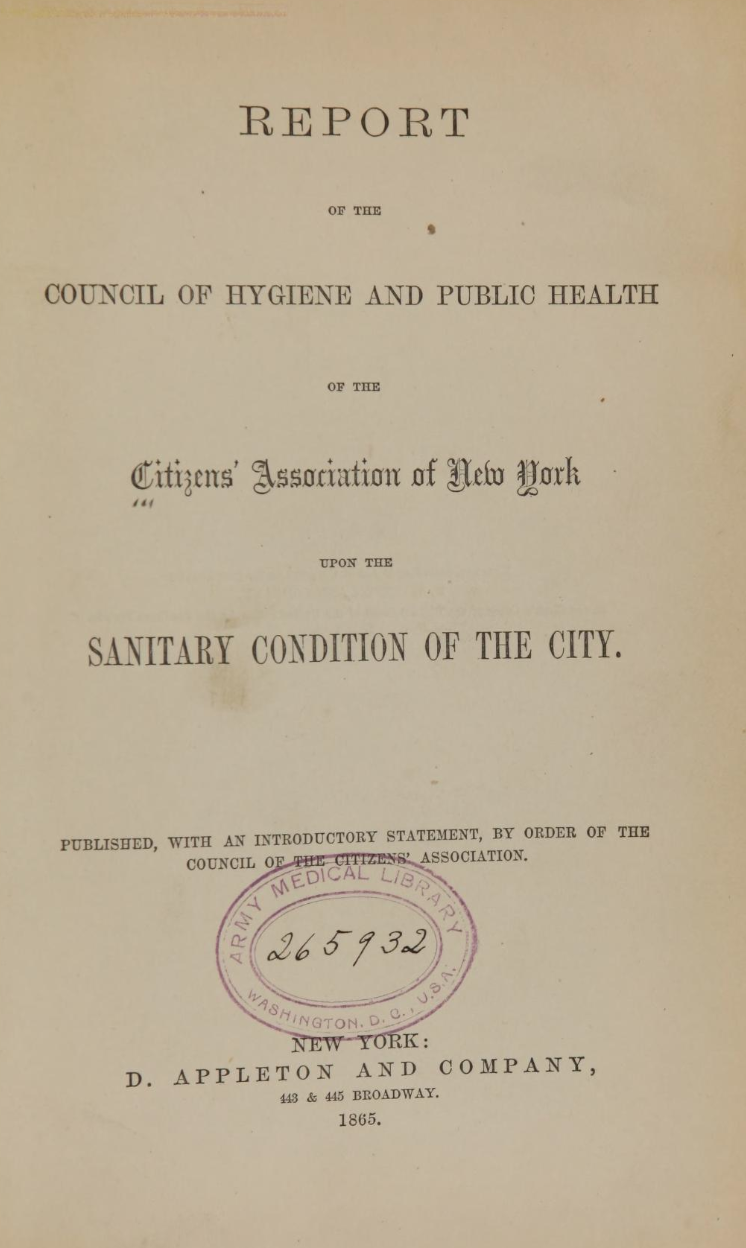#SouthOfUnionSquare: 813 Broadway and the Report of the Citizens’ Association of New York Upon the Sanitary Conditions of the City

Recently, full demolition permits were filed for 813 Broadway in the heart of Village Preservation’s proposed South of Union Square Historic District. 813 Broadway is a four-story residential and commercial building constructed around 1850 as an investment property for Peter Goelet, a prominent New York City merchant and real estate entrepreneur. Over its nearly 175 year history, this building has been the location of numerous historically significant civic organizations, including the Citizens’ Association of New York, an organization formed in 1863 by prominent New Yorkers which revolutionized public health practices not only in New York City but across the country.


The Association was founded by prominent New Yorkers including Governor, Senator, and Secretary of State Hamilton Fish; prominent merchant and philanthropist John David (J.D.) Wolfe; financier and philanthropist John Jacob Astor III; businessman, arts patron, and philanthropist Jonathan Sturges; Robert B. Roosevelt, politician and uncle and mentor to Teddy Roosevelt; financier, diplomat, Democratic National Committee Chair and Belmont Stakes-founder August Belmont; first Catholic American Presidential candidate Charles O’Conor; and railroad magnate and financier Morris Ketchum. While the Citizens’ Association of New York underwrote many civic studies, their most impactful contribution to public discourse was the Report of the Citizens’ Association of New York Upon the Sanitary Conditions of the City, which radically reshaped public health standards and practices in the city.



In 1864, the Citizens’ Association formed the Council on Hygiene and Public Health to underwrite a survey of sanitary and living conditions throughout all 31 districts in New York City, undertaking the remarkable and unprecedented task of visiting and interviewing residents of every household in New York City to amass a comprehensive picture of current conditions and propose improvements. Completed in 1865, the Report of the Citizens’ Association of New York Upon the Sanitary Conditions of the City included over 300 pages of ward-by-ward documentation of sanitary conditions, illness, population density, demographics, urban environment, and more in the form of detailed written descriptions and maps. At the time of its publication, the New York Times described the revolutionary report:
“At last we have a reliable report upon the social condition of New-York City; a report, moreover, that is no common one; no more compilation of statistical data, overpowering with figures and perplexing with misstatements. This is a book demanding and arresting attention; a live book; remarkable, not more for the extent of research and magnitude of labor involved in its preparation, than for the public spirit it represents and whereof it is the offspring.”




On top of creating the field of public health as it’s known today, the Report of the Citizens’ Association of New York Upon the Sanitary Conditions of the City is also an excellent record of population density in 1860s New York and innovation in data visualization. These maps help historians today understand the greater social context of the historic events that occurred in 19th-century New York.

813 Broadway in (from left to right) 1913, circa 1940s, and 2022.
While the building has lost some decorative details over the years, it retains the same overall utilitarian architectural character as displayed in the 1899 illustration and the 1913 photo shown above. The upcoming demolition of 813 Broadway illustrates a troubling future for the historic buildings South of Union Square if the neighborhood is left unprotected. Recently, the proposed South of Union Square Historic District was named one of 2022-2023’s “Seven to Save” — the biannual list of the most important endangered historic sites in New York State — by the Preservation League of New York State. This designation shines a spotlight on the incredibly valuable and varied architecture of this neighborhood, and its deep connections to civil rights and social justice history as well as transformative artistic, literary, and musical movements.
We have received a series of extraordinary letters from individuals across the world expressing support for our campaign to create a historic district for the neighborhood South of Union Square. To help protect these incredible historic structures and other buildings in this neighborhood, click here.
